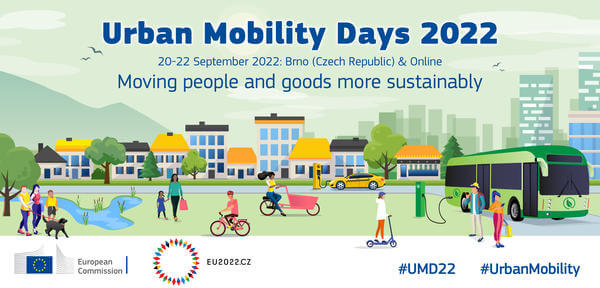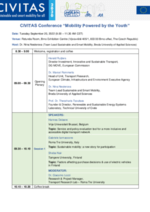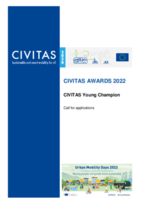Urban Mobility Days 2022
ConferenceMobility Powered by Youth

The Urban Mobility Days 2022 took place from 20-22 September 2022, from Brno (CZ). Hosted in cooperation with the Czech Presidency, this three-day conference was held in a hybrid format. This year, the theme was 'Moving people and goods more sustainably'.
The Urban Mobility Days conference series takes place every two years and combines two previously leading events from Europe’s transport calendar: the CIVITAS Forum Conference and the European Conference on Sustainable Urban Mobility Plans (SUMPs). It provides the ideal opportunity to network, debate key issues, and exchange ideas on emerging transport trends and technologies, the latest developments in sustainable urban mobility planning, and solutions to make mobility in cities and towns more sustainable.
Attracting policymakers, local authorities, academics, NGOs, urban transport practitioners and more, the Urban Mobility Days provide a valuable opportunity to exchange knowledge on current mobility topics. The conference combines two leading events from Europe’s transport calendar: the CIVITAS Forum and the former European Conference on Sustainable Urban Mobility Plans (SUMPs).
This year, the event celebrated the twentieth anniversary of the CIVITAS Initiative. As 2022 is the European Year of Youth, attendees witnessed a larger representation and involvement of young people in the conference, as well as and dedicated time spent discussing themes linked to urban mobility and the European Green Deal.
We hope to see you at the next Urban Mobility Days! In the meantime, you can find a selection of photographs from the event on Flickr HERE.(link is external)
Youth rapporteurs were crucial members of the Urban Mobility Days team, distilling key insights from sessions, and presenting their conclusions during the event's closing plenary. Open the blue accordion below to click through their reflections from each event session. These summaries were authored by Isabel Bezerra da Cunha, Jennifer Hostland, Katerina Kührová, and Hannes Delaer, and edited by the CIVITAS Secretariat.
The first plenary session got to the core of EU urban mobility, focusing on planning for public transport and active modes, as well as reducing oil dependency.
All towns and cities can, and must, provide sustainable mobility alternatives – this work cannot be for only the biggest and richest cities. Sustainable mobility cuts across all sectors. Mobility education is crucial, and many areas in Europe face a shortage of public transport drivers, pointing to the need to make working in public transportation attractive to more diverse workers. Low cost of public transport tickets is not enough to foster a shift if proper infrastructure, services, and inclusivity measures are not in place.
Transportation needs to be safe, inclusive and affordable. Cycling and walking need to be treated as fully fledged modes of transport and funded properly, investing at least 10% of national transport budget into cycling. Streets need to be separated, protected and safe.
Urgency to reduce oil dependence is only rising. It is necessary to take action now and invest money proactively (e.g. in sustainable transport), as opposed to only acting reactively to energy crises (e.g. tax cuts to offset high fuel costs). The longer we wait, the higher the consequences will be. There will always be resistance to change; but, as sustainable transport evolves, people generally don’t feel the need to go back to car dependency. Change is possible with more coherence between speeches, policies and actions, as well as strategic financing tools. To address shocks like the onset of COVID-19 or the war in Ukraine, we need to focus on multi-modality rather than treating all transport modes independently. There is a need to start speaking the language of politicians and learning how to ally with politicians to make change within their elected period.
The Trans-European Transport Network (TEN-T network) is one of the backbones of the European transport system. TEN-T is considered the most important European network for both passenger mobility and logistics, and the cities that form its nodes are crucial to its functioning. Currently, however, these cities are often also considered bottlenecks, leading to negative externalities like congestion, which has serious economic and environmental impacts.
The City of Antwerp and the City of Bremen realised that a significant contributor to congestion is a large number of commuters travelling in from outside the city on a daily basis. A lack of good alternatives pushes people to private car use. The Deputy Mayor of Antwerp thus suggested also considering the outskirts of cities when working on sustainable mobility solutions for TEN-T nodes. It was concluded that these nodes perform a crucial function, but are currently under too much pressure from existing transport demands.
This session explored what funding and financing cities need to achieve climate neutrality, and the ways both public and private funding opportunities can address these needs. Furthermore, the panellists discussed barriers that are slowing down the shift from research and innovation to large-scale uptake of these innovative solutions.
Representatives from DG MOVE and CINEA presented European Commission funding opportunities, and discussed the role of the European Investment Bank. However, public funds will not be sufficient to achieve ambitious climate-neutrality goals. Cities must increase the number of bankable projects that attract private money; however, it may be hard for such projects to offer the direct benefit to private investors. There may, thus, be a need to re-define "bankable" versus "risky" projects, drawing on holistic approaches, finding common rationale among public and private investors, and involving public resources to increase returns on projects.
Cities fear faces complicated bureaucracy to secure funding, especially for innovation implementation. The importance of technical assistance platforms, like JASPERS, was thus stressed.
This session explored challenges and opportunities with respect to Sustainable Urban Mobility Plan (SUMP) implementation across Member States, considering potential local, regional, and national action. Panellists highlighted the importance of exchanging knowledge and capacity across these levels to guarantee successful implementation.
At present, there is uneven implementation of SUMPs across Europe – in other words, while SUMPs are fully implemented and appraised in some cities, others are struggling to take even the first steps towards creating a SUMP. These cities need direct support and cannot be left behind. Audience suggestions to tackle the implementation gap included, for instance, the creation of a SUMP Task Force able to bridge the gap between the local, regional, and national levels. Some participants also believed that SUMPs should not be too restrictive or precise, and should have a greater degree of flexibility for cities; this was in contrast to suggestions that implementation requires national SUMP regulations.
Data collection and operationalisation are perpetual challenges, which could be eased by standardising SUMP indicators at the national level. Furthermore, collaboration between regions and cities can bridge data gaps and build capacity to implement SUMPs.
In total, 377 cities applied to be part of the European Commission's Climate-neutral Cities Missions, and 100 cities were selected to receive European funding and support to become climate-neutral by 2030. These cities' climate-neutrality commitments include planning innovations for major polluting sectors such as energy, waste disposal and transport, as well as ensuring meaningfully citizen participation during this process. This will require significant work from cities, taking multidisciplinary approaches, and focusing on long-term positive effects.
This session not only explored the so-called "Cities Mission", but also presented a good example of integrated planning in Paris, whereby bus depot renovations will also include building social housing and creating green spaces in the city. Panellists emphasised the need for simple solutions with quick gains that impact everyone in the city more-or-less equally, such as circulation plans (compared to, for example, Low Emission Zones). Such changes can be implemented fast and require limited investment.
Cities were also encouraged to consider all possible impacts of interventions; increasing quality of life in neighbourhoods may, for example, increase housing and living prices, out-pricing vulnerable communities. This is not only unjust for those communities, but also leads people to move out of the city proper, thereby increasing the number of commuters that have to rely on private cars. Although there are still a lot of hurdles that need to be taken into account, the discussion and example from Paris showed that cities are adapting to the needs of the future.
This session explored Sustainable Urban Mobility Indicators (SUMIs), which have been proposed to support pan-European monitoring of progress towards sustainable urban mobility. Cities often struggle to monitor their Sustainable Urban Mobility Plans (SUMPs), which poses a real challenge to evidence-based decision making. Coordinated monitoring of certain indicators is one way to reduce the administrative burden on cities, while also opening up the ability to compare impacts between cities.
However, the session pointed out concerns that currently proposed SUMIs can be too complex, and require resource-intensive data collection. Data collection must be not only robust, but also efficient and justified – cities need to know why they have to collect certain types of data. Furthermore, adequate resources must be available to cities for this task. On the other hand, the session pointed out that it is a real challenge to balance indicator simplicity versus indicator relevance and robustness.
The European Commission's REPowerEU Plan responds to the impacts of Russia's invasion of Ukraine on energy markets, emphasising the need both to end EU dependence on Russian oil, and to tackle the climate crisis. This session delved into how sustainable mobility solutions can address oil dependency, climate change, and energetic and geopolitical complexities. For example, the session demonstrated how cycling is helpful in the face of war in Ukraine, bringing clear evidence that the bicycle, as a flexible, affordable mode of transport, can be an essential tool to support people in a critical situations.
The RepowerEU Plan calls for a modal shift towards active modes of transport (cycling and walking), and public transport. Panellists advocated for a planning paradigm shift whereby, instead of planning infrastructure to improve motorised mobility, cities use awareness campaigns and mobility management strategies to increase the attractiveness of active modes and public transport. Achieving a robust shift away from motorised vehicles requires significant behavioural change. Awareness-raising campaigns and Mobility Management Plans can be powerful tools to foster behavioural and attitudinal change. Individuals must be equipped with the necessary tools, subsidies, and knowledge to change their mobility patterns.
This session shared good practices from European-led projects being implemented outside the EU, with a focus on Sustainable Urban Mobility Plans (SUMPs). SUMPs have successfully been applied in different contexts; however, they still face challenges within and outside of Europe. Stakeholder participation can be challenging in many contexts, as can cooperation among local institutions, planning across entire functional urban areas, and coordination with other sectors and political levels. Banks also often lack knowledge regarding expectations (or obligations) to fund SUMPs and urban mobility.
Many cities outside of Europe face unique sustainable mobility challenges. For example, the session pointed out that paratransit – i.e. transport modes that provide rides without fixed routes or timetables – provide 60-90% of transport services in many cities in the so-called "Global South". In addition, a majority of cities outside of the EU do not have coordinated sustainable urban mobility guidelines. Plus, very large cities face different mobility challenges altogether, and the world's largest cities are expected to increasingly be located in Asia, Africa and Latin America.
Cities need support accessing good quality data, resources (both financial and human), and capacity. Projects must be set-up with local leadership; European project leaders should be redundant, and funding must be in place to support local ownership over projects. Learnings must be mutual: flowing freely between European and non-European partners.
This session was organised as a 'World Café' discussion: following a short introduction to the CIVITAS Initiative, participants were divided into four groups that rotated between tables to discuss four questions regarding the future of CIVITAS.
The first table explore how the CIVITAS Initiative could better cooperate with and contribute to EU processes, such as the EU Urban Mobility Framework, the Fit for 55 Strategy, and the European Green Deal. The community, knowledge, and network CIVITAS brings together can be better exploited. One proposal was to establish thematic knowledge pools to facilitate various initiatives working together via joint working groups, trainings, and communication events.
The second table discussed future roles for the CIVITAS Policy Advisory Committee (PAC). PAC members were encouraged to bring CIVITAS to their local communities, acting as CIVITAS ambassadors. Better external communication of PAC work was proposed to achieve greater transparency. CIVITAS projects can share policy recommendations directly to the PAC, who can then push them at the EU level. Furthermore, more diverse geographical representation in the PAC has been suggested.
Third, the involvement of youth in CIVITAS was discussed. Structured cooperation between students and CIVITAS projects was explored, as was a potential role for CIVINETs in local youth involvement. Capacity building activities targeting teachers were also suggested. Participants suggested broadening the target group from university students, to also include children (under 18) and young professionals (up to 35). Involvement of students from different disciplines was also stressed.
Finally, table four looked at how to strengthen the role of CIVINETs as local ambassadors of the CIVITAS Initiative. Strengthening dialogue between the CIVINETs will be crucial. The CIVINETs need a platform where they can easily find peers, their areas of expertise, and how they can support each other. The importance of stable and predictable budget for every CIVINET was also stressed, as CIVINET budget is currently structured around applications to the CIVINET Activity Fund.
Urban Vehicle Access Regulations (UVARs) include a number of schemes that limit traffic, pollution, and congestion, such as Low Emission Zones, circulation plans, and congestion charging. Parking management is a cornerstone of effective UVARs. This session thus introduced a new parking auditing tool (the PARKPAD tool) to help cities create appropriate parking management schemes.
Although many UVAR schemes are successfully implemented in cities or regions, there is very little communication or data sharing across cities or regions, never mind across national borders. Sharing data about vehicles and drivers will be crucial for improved UVAR roll-out. A tool that digitalises UVAR data from across Europe was then introduced. Such a tool serves to make vehicle data available for road users and local authorities, supporting the enforcement of vehicle access regulations.
There is clear evidence that we must improve safety for vulnerable road users (VRUs); 70% of road collision deaths are among VRUs, and one third of fatalities occur in urban areas. Road safety needs to be integrated in SUMPs, and must be evidence- and science-based, with diverse stakeholders involved in planning safety measures.
What's more, improving safety is key to encouraging behaviour change, encouraging people to become cyclists. Instead of being reactive with respect to safety, proactive measures should be implemented to invite people to switch to active modes. Speed, space, and good public transport are all essential. Temporary cycling measures are a great way to implement infrastructure quickly, review its success, adapt, and open the door to permanent change.
People-centric planning is essential, and politicians, planners and engineers need the courage to make change. Furthermore, planning must take into consideration new mobility options (e.g. e-scooters, e-bikes), and more diverse perspectives must be accounted for, such as the inclusion of children, the elderly, those with disabilities, those from a different racial background, and more. Smaller municipalities may require technical expertise and analysis to make road safety a reality.
Cities are not only developing Sustainable Urban Mobility Plans (SUMPs), but also Sustainable Energy and Climate Action Plans (SECAPs). This session explored efforts in Cluj-Napoca (RO), Parma (IT) and Prague (CZ) to harmonise these plans. Two overarching messages emerged. First, we need to bring innovation to governance structures. Governance of mobility and energy within cities must be harmonised if we have any chance of effectively making mobility and energy plans coherent. Governance structures must be open to integration of other sectors, such as waste management, and has to be open to innovation. Second, the departments cooperating on integrated plans have to share an overall vision and set of priorities. Long-term cooperation, involvement of as many stakeholders possible, establishing a good communication strategy, and ensuring real participatory processes are all critical.
Zero-emission last-mile deliveries, and zero-emission urban freight logistics are crucial issues. Achieving these goals requires collaboration among local authorities and private stakeholders to better integrate logistics planning in overall urban mobility plans, in data management, and in changing business requirements. This session highlighted the need for horizontal collaboration between the city, retailers, service providers, and citizens.
Existing solutions like cargo bikes, zero-emission vehicles, mobility hubs, and dynamic routing must be developed and deployed quickly. Systemic change should also be considered, such as investing in infrastructure to encourage a modal shift to rail, reviewing the fiscal regime for road haulage, and adopting zero-emission vehicles in municipal fleets.
Intelligent Transport Systems (ITS) can be used to improve safety and efficiency of mobility systems, addressing topics including decarbonisation, ageing populations, and new urban planning. To successfully implement ITS, public-private collaboration is necessary, with all parties sharing a common agenda, vision, and good data. Data sharing is a persistent challenge with respect to ITS solutions that closely involve private companies in competitive environments.
A pre-requisite to digitalisation is that basic transport needs, such as public transport and bike infrastructure, are firmly in place. Indeed, mobility solutions must be seen as related and designed in an integrated manner. Mobility hubs and smart hubs can be used as an opportunity to reallocate space, and micromobility can be used to provide first- and last-mile solutions. On a policy level, there is a need for ITS frameworks.













